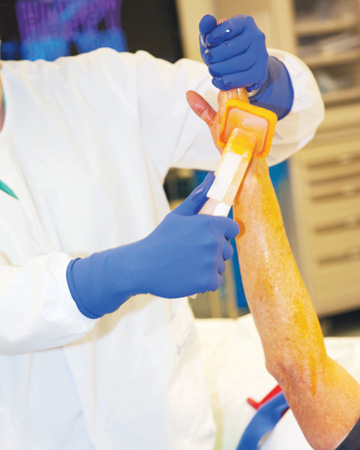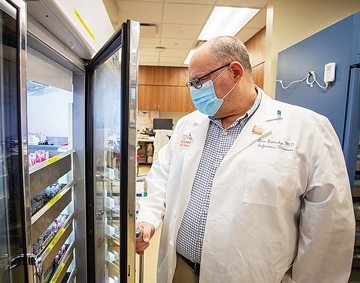Riding the Wave of Change
As a leader, you need to look ahead for long-term solutions to an ever-changing environment while at the same time dealing with daily challenges....
This website uses cookies. to enhance your browsing experience, serve personalized ads or content, and analyze our traffic. By clicking “Accept & Close”, you consent to our use of cookies. Read our Privacy Policy to learn more.
By: Kendal (Gapinski) Kloiber | Contributing Editor
Published: 12/6/2021
We’re almost two years into the pandemic and by now the revamped infection prevention protocols you rushed to implement in order to keep your doors open must feel like standard practice. From requiring COVID-19 tests before surgery to making sure ORs are wiped clean between cases, there’s never been more on the to-do lists of hardworking (or is it overworked?) infection preventionists. That’s not necessarily a bad thing. “The pandemic has had several positive impacts on infection prevention protocols in outpatient settings,” says Jessica Seidelman, MD, MPH, an assistant professor of medicine at Duke University School of Medicine in Durham, N.C.
Dr. Seidelman points out that hand hygiene among patients and healthcare workers has improved, and surgical staffs are more diligent in disinfecting equipment and scrubbing surfaces. She believes patient screening for communicable diseases or symptoms of infection before surgery has become paramount, and the application and use of personal protective equipment have been reemphasized and prioritized.
The continuing pandemic and emergence of worrisome variants further underscore the need to have a strong infection prevention protocol in place, but dotting the i’s and crossing the t’s on the individual policies can be challenging,
says Luis Ostrosky, MD, FACP, FIDSA, FSHEA, FECMM, CMQ.
“During last year’s elective surgery shutdown, many surgical facilities sat empty,” says Dr. Ostrosky, a professor and chief of the division of infectious diseases at McGovern Medical School of UTHealth in Houston.
“When procedures resumed, staffs played catch-up by working through heavy caseloads of backlogged cases. That’s when trouble can occur.
It’s easy to become lax when things get busy.”
With all of this in mind, now’s the time to review how you’re approaching infection prevention and dive deeper into practice areas that can have a big impact on protecting your staff and patients from dangerous viruses and pathogens.

Here are several best practices to focus on when reviewing your infection prevention policies, according to Jessica Seidelman, MD, MPH, an assistant professor of Medicine at Duke University School of Medicine. Run down the list to determine how robust your current protocols are and where they could improve. — KK

Dr. Seidelman says a strong infection prevention program addresses modifiable factors that increase infection risks in patients such as blood glucose levels, body-mass index, smoking status, history of prior infections and skin antisepsis. He says infection preventionists should also implement comprehensive surface disinfection protocols, and maintain oversight of instrument reprocessing practices and compliance with surgical attire guidelines.
There are other critical areas to focus on when ramping up your facility’s infection prevention efforts:
• Pre-op screenings. New COVID-19 precautions that involved checking patients’ temperatures and screening for symptoms of infection prior to their arrival for surgery meant that more facilities were able to identify patients with active infections before letting them undergo elective outpatient procedures, says Dr. Ostrosky.
Research has clearly shown that the risk of surgical woud infections dramatically increases when patients have an active infection at another site.
“The main thing that happened with the pandemic is that facilities realized there was a need to be more diligent in screening patients for illnesses,” adds Dr. Ostrosky. “Many realized that patients with active infections were being operated on when in reality their cases should have been delayed.”
• Surface cleaning. Dr. Ostrosky notes that surgical facilities have reemphasized the importance of treating surfaces, inside the OR and throughout common areas. They switched to more powerful cleaning agents with formulations that are effective against COVID-19 and other microorganisms. “There are a few silver linings to the pandemic, and one is that cleaning procedures became much more stringent,” says Dr. Ostrosky.
To comply with the latest surface disinfection requirements, look to CDC and AORN guidelines for the most effective products and practices. If you want to take surface disinfection to the next level, consider incorporating high-tech solutions such as ultraviolet light (UV-C) technology, which kills or inactivates microorganisms by destroying nucleic acids and disrupting their DNA.
Overhead fixtures are available that filter and treat circulating air with UV-C light. Dr. Ostrosky’s facility employs mobile robots that direct UV-C light at exposed surfaces to kill remaining bacteria. “We found the units to be very useful, especially for room turnovers and for use on a nightly basis to reduce the overall bioburden of the rooms,” he says.
Keep in mind that these platforms should be used as an adjunct to comprehensive manual cleaning. They’re not effective during terminal cleaning of ORs or between-case room turnovers involving patients with known pathogens if the surfaces they’re treating have not been thoroughly wiped down.
• Nasal decolonization. Dr. Ostrosky says significant amounts of research show decolonizing carriers of MRSA before surgery reduces the risk of SSIs. Some surgical professionals believe this protocol should be applied to certain patient groups — those undergoing implant procedures, for example — but you’re much more likely to prevent infections and the spread of MSRA by screening all patients and treating carriers with the topical antibiotic mupirocin for five days leading up to their surgeries. However, concerns about antibiotic resistance and the not-so-insignificant burden — for patients and providers — of scheduling screenings and prescribing the treatment has led some facilities to treat the nares of all patients in pre-op on the day of surgery with povidone-iodine swabs or an alcohol-based antiseptic.
• Antimicrobial prophylaxis. Standardized preoperative antimicrobial prophylaxis is one area that’s been a key improvement in infection prevention practices and something to reprioritize, says Dr. Seidelman. Advancements such as all-in-one applicators have made applying skin prepping solutions simpler and more efficient for staff. Preoperative CHG baths deserve a place in your infection prevention protocol, as well. Have patients wipe down their skin or bathe with CHG solutions the night before and day of surgery to help reduce the number of pathogens around the surgical site. Take-home, all-in-one application kits with easy-to-follow instructions make the process easier than ever for patients.
As a leader, you need to look ahead for long-term solutions to an ever-changing environment while at the same time dealing with daily challenges....
During Perioperative Nurses Week this November 10-16, we encourage you to recognize the invaluable contributions of your perioperative nurses and nurse leaders....
At the core of a top functioning team is the well-being of every one of its members — and that includes the leadership, too....